The product recommendations in this post are recommendations by the writer and/or expert(s)
interviewed and do not contain affiliate links. Meaning: If you use these links to buy
something, we will not earn a commission.
Mac & cheese is the ultimate comfort food. Creamy and lusciously cheesy, it’s the perfect side dish for a family dinner or a complete meal in and of itself. (Don’t act like you’ve never done it!)
Wildly convenient, frozen mac & cheese options turn this classic dish into an even quicker and easier meal solution. You don’t need to wait for water to boil, purchase a pound of cheese if you’re making it from scratch, or deal with dirty dishes after the whole production. All there is to it is to pop it in the microwave (or oven) for a few minutes and enjoy!
Unfortunately, this convenience comes at a cost to your health. Frozen mac & cheese is often loaded with excess calories, fat, and sodium. And because it’s ready to heat and eat, you can’t adjust the recipe to fit your health needs as you would when making it at home; there’s no chance of opting for skim milk over 2%, swapping full-fat cheese for reduced-fat, or making sure you’re not overdoing it on the salt shaker. The only way you can control your calorie and fat intake is by shrinking your portion size—and we all know how hard that is to do when most products are packaged in “single-serve” sizes.
To help uncover the worst options in the freezer aisle, we spoke to registered dietitians, who gave us some advice on how to identify what makes a frozen mac & cheese product unhealthy.
How to spot the unhealthiest frozen mac & cheeses
Here are 5 things to keep in mind when choosing frozen mac & cheese:
- Organic doesn’t mean it’s healthier or tastes better. “There are several brands that market their product as organic but that doesn’t mean the product is necessarily healthier,” says Amber Pankonin, MS, RD, registered dietitian, and owner of the food blog Stirlist. “It will still contain calories and sodium so be sure to compare nutrition facts labels.”
- Always check the serving size “Nutrition labels provide valuable information about the mac & cheese’s ingredients and their nutritional value,” says Maggie Michalczyk, RDN, founder of Once Upon a Pumpkin. “Pay close attention to serving sizes, calories, fat content (especially saturated fat), sodium levels, and added sugars. It’s also important to look at the serving size of the item because that is what the nutrition label refers to, not the entire package unless otherwise specified.”
- Sodium content is typically high among most brands. “Since frozen mac and cheese is a convenience item, many brands contain a high amount of sodium ranging from 500-2500 mg of sodium per serving,” says Pankonin. “If you have high blood pressure or are sensitive to salt, this might be something you want to keep in mind when comparing brands.”
- Watch for excessive fat and sugar “Diets high in saturated fat are associated with increased risks of heart disease,” says Michalczyk. “Similarly, added sugars contribute to empty calories and can lead to weight gain and other health problems. Select mac & cheese products with lower saturated fat and minimal added sugars to promote a more nutritious meal.”
- Specialty ingredients could increase fat, calorie and sodium content. “The addition of animal products, ingredients like buffalo or barbeque sauce or breadcrumbs can increase overall calorie content and especially sodium content,” says Pankonin. “This is something to be mindful of if specialty ingredients are appealing to you.”
Here are 7 of the worst frozen mac & cheese brands, according to dietitians.
With questionable ingredients and an abundance of nutrients that put your health at risk when eaten in excess, these frozen mac & cheeses are better left in freezer cases. Take charge of your health by avoiding these picks, and the next time you’re looking to satisfy your cheesy mac craving, don’t miss these The Best & Worst Boxed Mac and Cheeses, According to Dietitians.
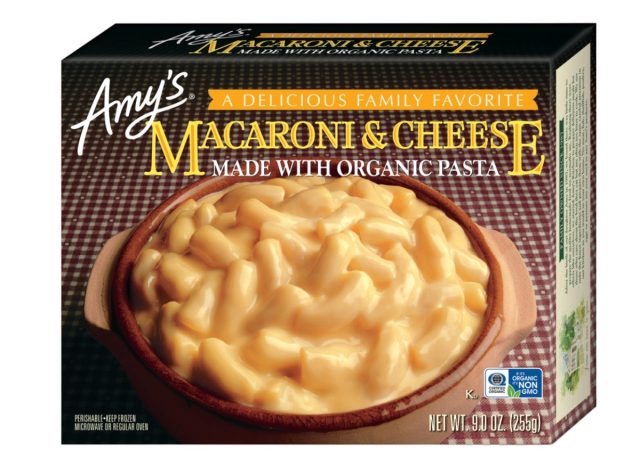

Per Serving: 450 calories, 18 g fat (10 g saturated fat), 680 mg sodium, 55 g carbs (3 g fiber, 5 g sugar),18 g protein
“This option isn’t necessarily a bad choice but it does show that organic doesn’t mean it’s going to be low in calories,” says Pankonin. “This organic option still contains 55 grams of carbohydrate, 5 grams of sugar, and 18 grams of fat.”
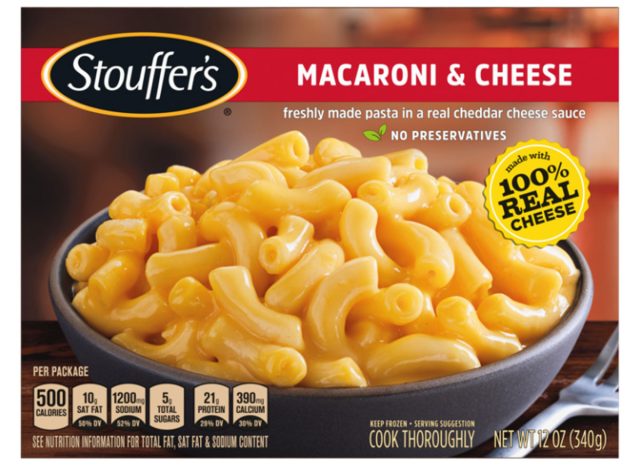

Per Serving: 480 calories, 21 g fat (9 g saturated fat), 1,280 mg sodium, 51 g carbs (2 g fiber, 5 g sugar), 21 g protein
Single-serve frozen mac & cheeses are particularly unhealthy because it’s easy to polish off an entire container in one sitting—which in this case will set you back nearly 500 calories. “Stouffer’s Frozen Mac N Cheese is extremely high in sodium and high in saturated fat,” says Michalczyk. “It’s also higher in calories per serving than other options.”
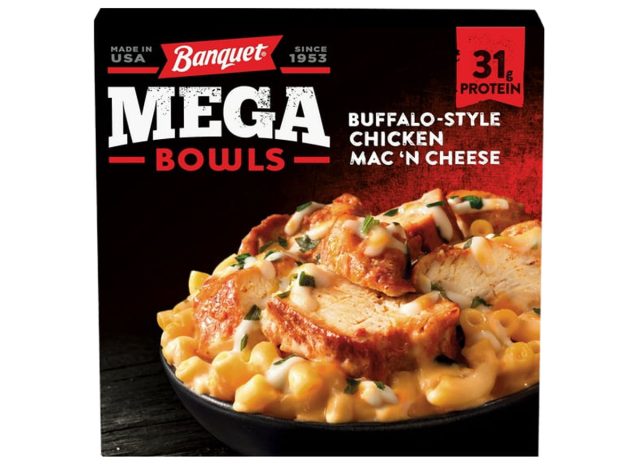

Per Serving: 490 calories, 17g fat (6 g saturated fat), 2,130 mg sodium, 56 g carbs (0 g fiber, 10 g sugar), 28 g protein
READ RELATED: Costco Expanding to a New State for the First Time
“This particular flavor variety includes animal protein and buffalo sauce which drives up sodium content,” says Pankonin. “Total sodium is 2130 milligrams, and that’s due to the added buffalo seasoning and additional salt used to season the chicken.”
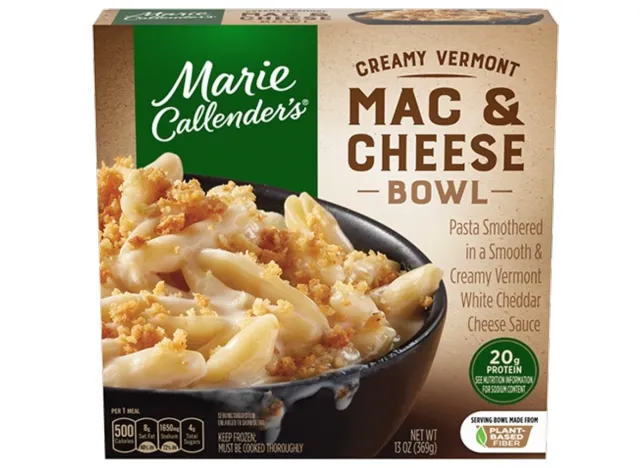

Per Serving: 570 calories, 22g fat (13 g saturated fat), 1,230 mg sodium, 71 g carbs (5g fiber, 5g sugar), 21 g protein
“This flavor variety includes breadcrumbs, which is going to make it a little higher in carbohydrates compared to other options,” says Pankonin.
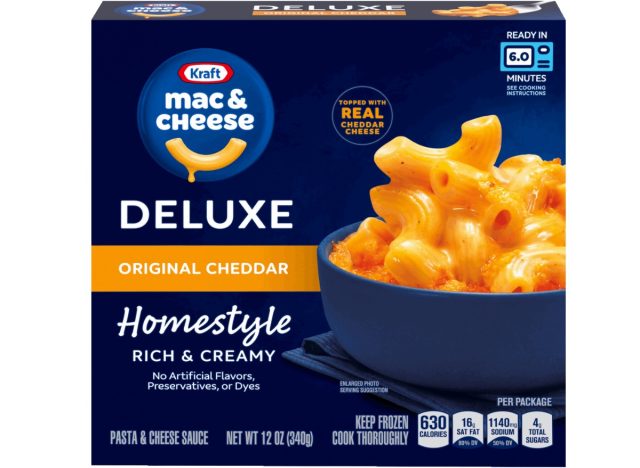

Per Serving: 320 calories, 11 g fat (3 g saturated fat), 900 mg sodium, 41 g carbs (1 g fiber, 4 g sugar), 12 g protein
Famous for their boxed mac & cheese, Kraft just debuted a frozen option, and it’s one you should avoid if you’re looking out for your health. “This Kraft variety is high in fat and very high in sodium per serving,” says Michalczyk.
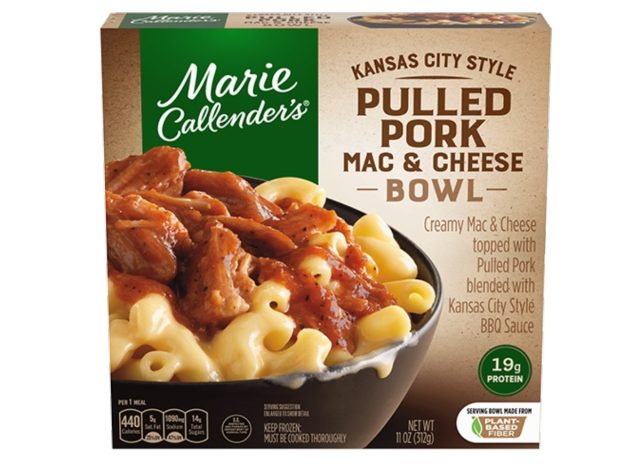

Per Serving: 440 calories, 14 g fat (5 g saturated fat), 1,090 mg sodium, 59 g carbs (3 g fiber, 14 g sugar), 19 g protein
“The addition of pulled pork with barbeque sauce in this option can make it a little higher in sodium and sugar compared to other options,” says Pankonin.
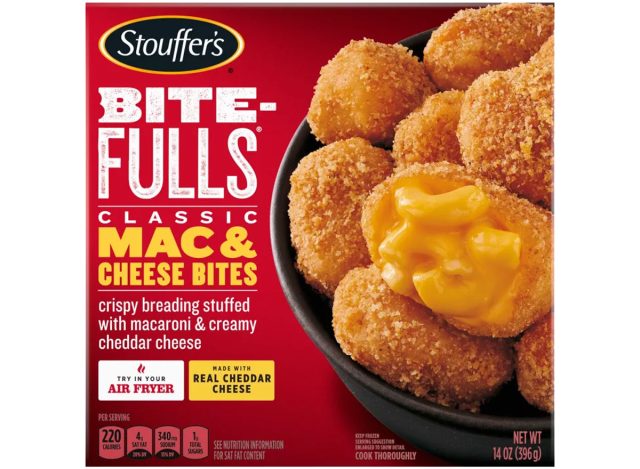

Per Serving: 220 calories, 11 g fat (4 g saturated fat), 340 mg sodium, 23 g carbs (1 g fiber, 1 g sugar), 6 g protein
These may seem lower in calories, but there are 5 servings—and one serving is just 3 “bites.” Plus, they’re breaded. “Sodium is always a concern when it comes to convenience items,” says Pankonin. “So, if you have high blood pressure, you might want to find a different option.”









